|
|
 |
 |
 |
 |
 |
 |
 |
History
 |
 |
 |
 |
[Forum
2006 in Singapore] [Forum
2005 in New York City] [Forum
2004 in Hamburg] [Forum 2003 in
Stockholm] [Forum 2002 in TOKYO]
| Façade
Lighting - Theme of Transnational Tanteidan Forum 2006 in Singapore |
| |
|
|
|
|
|
|
|
|
 |
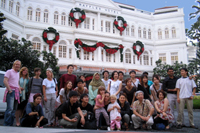
|
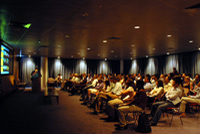 |
| |
|
|
|
|
|
|
|
|
|
Transnational Tanteidan Forum 2006 in Singapore
In 2001, the Transnational Tanteidan Forum started in Tokyo, moved to Europe and the US, and, now in its fifth year, the forum was held in the tropical island-city of Singapore. Once again chapter members gathered for the yearly event to get reacquainted and share lighting experiences.
Façade Lighting
The theme this year was façade lighting. The façade, said to be the face of architecture, is sensitive to light at night. Illuminations can add to a building’s charm and highlight it’s features, but can also leave a damaging expression. Architecture, the face of a city, creates a nightscape unique to each city and area. How façade lighting affects the nightscape of a city was the topic of this year’s forum.
The night started with our top presenter, Singapore member, Ms. Toh Yah Li. Yah Li introduced the different areas of Singapore, focusing on the CBD district and the skyscrapers along the waterfront. The reflection of this group of skyscrapers in the bay is distinctive of the Singapore nightscape, but the light permeating from the windows of high-rise public housing is also a classic view of Singapore.
Next on the program were Hamburg lighting designers, Mr. Christof Fielstette and Ms. Ulrike Brandi. The pair presented on the illumination of the city hall and other historical buildings with classic stone facades, but as a city situated on the waterfront, the relationship between light and water was another point of discussion.
Ms. Aleksandra Stratimirovic, formerly of Belgrade, Serbia, but now traveling between Stockholm and Belgrade, presented this year for the first time on her hometown. With many connections to architects and designers in the area, Ms. Stratimirovic, has started Lighting Detective activities in Belgrade. Her presentation included many images of a neat little town, with no hint that the country has been a battleground for many years. While there are areas of shadowy darkness, many of the main buildings are intensely illuminated in bright white light. Lighting Detective members are anxious to see how this city will be transform.
Ms. Katja Bülow presented Copenhagen, a city very protective of historical buildings and with strict laws governing facades and signage, a tactic to preserve the beauty of the city during long Scandinavian nights.
Mr. Kaoru Mende, of the Tokyo Chapter, presented the Tokyo nightscape in three categories: commercial, residential, and offices. The intensely lit facades from various districts in Tokyo, Ginza, Omotesando, Akihabara, Shinjuku, and Asakusa, dwarfed the other cities in the sheer amount of light produced.
After the individual presentations, Dr. Erwin Viray, assistant professor, Department of Architecture, National University of Singapore, moderated the panel discussion. European participants were most surprised by the amount of direct sunlight in Singapore. In northern Europe, they are constantly faced with the challenge of how to incorporate more light into buildings, the opposite of Singapore, where they continually seek shelter from the intense sunrays. Again, geography plays a huge role in the lighting culture of each
city.
|
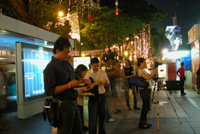 |
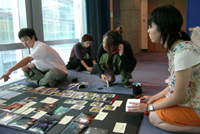
|
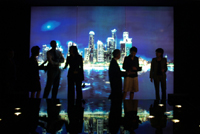 |
|
|
Heroes and Villains of Light
In conjunction with the forum, the Lighting Detectives also held and two-day
workshop, “Searching for Heroes and Villains of Light.” Singapore, was divided into 5 different areas for
surveying, including: ①Toa Payoh, a new and emerging residential area
②Orchard Road, Singapore’s main street ③Bugis, a cultural melting pot
④the charming waterfront along Singapore River
⑤the red-lantern dotted, Chinatown. Even though Singapore is a small
island-city, many unique communities are alive in this urban
area. After a full day of surveying, each team organized their data into two
groups: Heroes—good light and Villains—bad light, and, along with analytical
comments, laid-out on panels for presentation.
“LIGHTING UP OUR CITY CENTRE”
In conjunction with The Urban Redevelopment Authority of Singapore, "Lighting up our City Centre" a lighting master plan for Singapore’s city
center, designed by Lighting Planners Associates (LPA), was on exhibit at the URA Centre during the
forum. Running from November 22nd , 2006 through March 28th, 2007, the exhibit explores options to create a signature nightscape for this tropical city and lays out distinctive guidelines for four main
districts; Orchard Road, Singapore River, Bras Basah
Bugis, Central Business District (CBD) and Marina Bay. The exhibit was also a prime opportunity to introduce the Lighting Detectives to the residents of Singapore, with one corner or the exhibit room focused on their
activities.
|
| |
| Main Street Lighting
- Theme of Transnational Tanteidan Forum 2005 in NYC |
| |
|
|
|
|
|
|
|
|
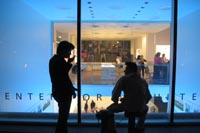 |
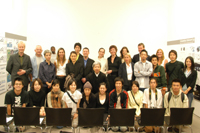
|
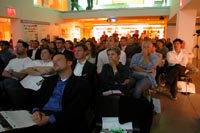 |
| |
|
|
|
|
|
|
|
|
|
It was another beautiful autumn day in New York City for the 4th Annual Transnational Tanteidan Forum. It all started 4 years again in 2001 with the first forum held in Tokyo. The network of Transnational Lighting Detectives has since grown throughout the world and once a year the core members gather to
stage, what has become, the annual TN forum. Presently, the core members consist of 11 members from 6 different
countries. This year’s forum was presented by the New York Chapter and held at the Manhattan AIA Center for
Architecture.
Main Street Lighting
This focus this year was again on public space, with the main theme: Main Street Lighting, a continuation from last year’s theme of Daily Transportation
Facilities. Main Streets are a feature of most cities and the purpose of these surveys was to see how each core member’s city was
illuminated. 200 plus architects, lighting professionals, and others gathered and passionately listened to the following 6
presentations.
The first presentation from Jason Neches, New York
Chapter, featured Manhattan’s 5th Avenue, Madison Avenue, and Times Square. The valley-like form of these streets from being enclosed by tall skyscrapers is the most recognizable
characteristic, but light from signage and window displays on the lower portion of the buildings creates most of the scenery along the
streets.
Aleksandra Stratimirovic, from the Stockholm Chapter, repeatedly used beautiful blue moment pictures in her presentation of Stockholm. The plazas at the beginning and end of this main street featured light
sculptures, landmarks in this city of melancholy winters.
Copenhagen Chapter member, Lisbeth Skindbjerg Kristensen, presented survey results from the famous Stroeget District of Copenhagen. The main form of street lighting in this area is through an efficient system of suspending lights over the streets from wires attached to buildings called Catenary
Lights.
Singapore Chapter member, Reiko Kasai, centered her presentation on the current redevelopment of downtown Singapore
street, Orchard Road. Presently, the street is lined with a monotonous line of sodium based
streetlights, but she and others are anticipating what kind of changes will be made as redevelopment
continues.
The Hamburg Chapter put a twist on the theme and featured the Elbe River and Lake Alster of this beautiful harbor
town. There are of course main streets, but the busy Elbe River is more of a lifeline in everyday Hamburg. Light from buildings along the shore and docked boats present a unique view of a “main
street.”
Leader of the Tokyo Chapter, Kaoru Mende, focused on Ginza Central Boulevard. Students from his Musashino Art University studio also participated in thoroughly surveying this main
street. Survey results and research included the history of Central Boulevard, streetlight design
survey, and a facade survey, but the highlight of the presentation was an 8-meter long scroll of 8 blocks along Central Boulevard. From this scroll the characteristics along the
street, trendy new lighting methods, and light distribution were easily
distinguishable.
|
| |
|
|
|
|
|
|
|
|
| Main
Street Lighting - With Statements from Tokyo, Singapore, Hamburg,
Stockholm, Copenhagen and New York City |
|
|
|
|
| Time |
Topic |
|
|
|
|
| 6:00
p.m. |
Gather at AIA Center for
Architecture. Light refreshments were be served. |
| 6:30
p.m. |
Introduction by Jason Neches of the New York Lighting
Detectives. |
| 6:45
p.m. |
Individual presentations from Copenhagen, Hamburg, New York, Singapore, Stockholm, Tokyo. |
| 8:30
p.m. |
Panel discussion of the theme "The Lighting of Public Space," moderated by Linnaea Tillett. Lighting Detective members from Copenhagen, Hamburg, New York, Singapore, Stockholm and Tokyo discuss the impact of light and public space in their respective
cities. |
| 9:30 |
"Get
together" |
| |
|
| Lighting
for Daily Transportation Facilities
- Theme of Public
Forum 2004 in Hamburg |
| |
|
|
|
|
|
|
|
|
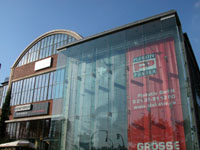 |
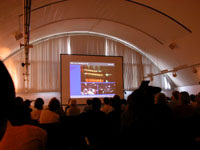
|
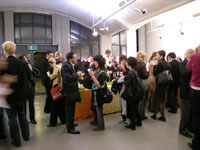 |
| |
|
|
|
|
|
|
|
|
| It
was the beginnings of autumn in the beautiful port city
of Hamburg, where the forum was held this year. The
dome-shaped hall, Freie Akademie der Kunste,
conveniently location near Central Station, was
illuminated by soft light creating a pleasant atmosphere
for all present. Hamburg, located in northern Germany,
with easy access to and from Scandinavia made it
possible for participants from Copenhagen to also join
in the fun. The forum, continuing from last year, was
again, well attended with about 150 persons registered.
This year was also a little different with a pianist
performing in between sessions.
The
theme this year was “Daily Transportation Facilities”,
meaning public transportation used everyday to get to
and from school and work. The core members from six
different countries reported on what kind public
transportation was used in their area and the lighting
environment of these facilities.
Kaoru
Mende presented details and pictures of how Tokyoites
endure the grinding morning rush day in and day out.
Pictures of squeezing more people into an already packed
train got a good roar from the crowd. Also, scenes from
around main stations, such as Tokyo and Shinjuku, lined
with shops and billboards, relayed how stations in Japan
are closely tied with commercialism. The white, unified
atmosphere created by long 110W fluorescent lights
covering many ceiling is definitely a characteristic of
Japan.
Recently, architects and designers have been
commissioned to design new stations along the
Minatomirai Line and other subway stations around Tokyo,
adding innovative lighting elements such as indirect
lighting or luminous walls. Other presentations included
reports on the spacious main concourse of New York
City’s Grand Central Station and the midnight sun
backdrop of Stockholm’s Central Station.
We realized
that in Japan, stations are just a place to pass through
on our way to somewhere, however other countries take
pride in their public facilities. Because stations are a
place that we pass through everyday they should be
comfortable and inject a little spice into the
atmosphere.
|
| |
|
|
|
|
|
|
|
|
| The
Lighting of Public Spaces - What is Public in Your City?
With Statements from Tokyo, Singapore, New York City,
Stockholm, Copenhagen and Hamburg |
|
|
|
|
| Time |
Lecturer |
Topic |
Download
presentation |
|
|
|
|
| 18:00 |
|
Welcome,
Introduction |
|
| 18:10 |
Matthias
Kirschnereit (piano) |
G.F.
Händel: Chaconne G-dur |
|
| 18:20 |
Werner
Oechslin |
Dark
Locations, Keynote Speech |
|
| 18:40 |
Matthias
Kirschnereit (piano) |
J.
Brahms: Walzer As-dur |
|
| 18:50 |
Saiko
Tanuma |
What
is Transnational Tanteidan? |
|
| 19:05 |
Kaoru
Mende |
Tokyo |
|
| 19:20 |
Reiko
Kasai |
Singapore |
|
| 19:35 |
|
Break |
|
| 19:45 |
Matthias
Kirschnereit (piano) |
Cl.
Debussy: Mouvement |
|
| 19:55 |
Ulrike
Brandi, Christoph Geissmar-Brandi, Chris Fielstette |
Hamburg |
|
| 20:10 |
Aleksandra
Stratimirovic |
Stockholm |
|
| 20:25 |
Katja
Bülow, Lisbeth Kristensen Skindberg |
Kopenhagen |
|
| 20:40 |
Eleni
Savidou, Jason Neches |
New
York City, Washington D.C. |
[presentation
New York City] [presentation
Washington D.C.] |
| 20:50 |
Matthias
Kirschnereit (piano) |
S.
Rachmaninow: Prelude |
|
| 21:00 |
|
"Get
together" |
|
Transnational
Tanteidan Forum 2003 in Stockholm
|
|
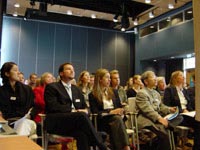
|
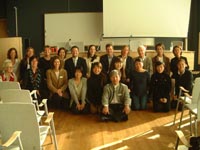
|
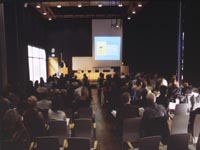
|
|
|
|
|
|
|
|
|
The Transnational Tanteidan Forum 2003 was held in Stockholm on August 29th, 2003 at the Kulturhuset
Haninge, approximately 30 minutes by train from the city
center. The forum was a great success. To our delight, the number of attendees exceeded our expectations and a change of site was necessary in the preceding
days. Almost 200 people attended and enjoyed the afternoon
forum.
The forum's theme was "Residential Neighborhood
Lighting." Core members from Tokyo, Hamburg,
Copenhagen, Singapore, Washington and Stockholm reported results of their research into Residential
Lighting. The difference between the international cities is very interesting and offers a unique window on the life of each
nation.
Most spend daily life without any notice of the lighting around us. But think one minute to change your life with lighting at your
home. It might be very interesting to investigate lighting around you once again in order to create something
special.

|
| Time |
Lecturer |
Download
Presentation |
| |
|
|
| 11:00-12:00 |
Ljusforum introduction in swedish
Bengt Knave |
|
| 12:00-13:00 |
Lunch |
|
| 13:00-13:05 |
Welcoming KTH Agneta Ejhed |
|
| 13:05-13:15 |
Ljusforum introduction in English,
Bengt Knave |
|
| 13:15-13:30 |
Lighting Detectives
introduction,
Saiko Tanuma |
|
| 13:30-13:50 |
RNL
Tokyo, Kaoru Mende |
|
| 13:50-14:10 |
RNL New York, Jason Neches |
[presentaion
New York City] |
| 14:10-14:30 |
RNL Hamburg, Ulrike Brandi |
|
| 14:30-14:50 |
RNL
Copenhagen, Katja Bülow |
|
| 14:50-15:10 |
RNL
Singapore, Reiko Kasai |
|
| 15:10-15:30 |
RNL Stockholm, Aleksandra Stratimirovic |
|
| 15:30-15:45 |
Break |
|
| 15:45-15:55 |
Conclusion Christoph Geissmar-Brandi |
|
| 15:55-16:40 |
Panel discussion Jan Ejhed, Kaoru
Mende, Christoph Geissmar-Brandi, Bengt Knave |
|
| 17:00-19:00 |
Reception Party |
|
|
|
|
|
Regional Lighting
Environment - Theme of Tanteidan Forum 2002 in TOKYO
|
|
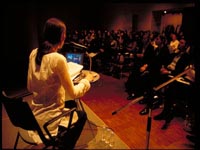
|
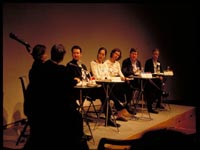
|
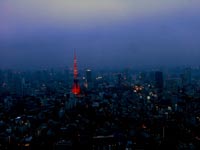
|
|
Theme of Transnational Tanteidan Forum 2002 in TOKYO was
"Regional Lighting Environment.” Various regions
around the world have nurtured characteristic cultures
of light. The globalization of information and industries,
however, has been standardizing lighting technologies,
which has caused the loss of unique lighting cultures
created through individual ethnic culture, climate, history,
religion, and social conditions. It is interesting to
comparatively study people’s living environments
with the focus on "regional light.” Through
discussing similarities and differences in cultures, we
may contribute to the preservation of characteristics
in regional lighting cultures and create new cultures
of light.
Lighting Detectives always researches and studies the
current lighting environment of a place. Light is "collected,”
categorizing lights into four groups: urban lighting,
architectural lighting, residential lighting, and lighting
of special events and celebrations. The current situations
are researched and reported. We seek significance in lighting
through comparing and analyzing the lighting environments.

|
 |
 |
Matrix of the Regional lighting
|
|
 |
 |
|
|
|
|
|
|
 |
 |
 |
|
|
|
 |